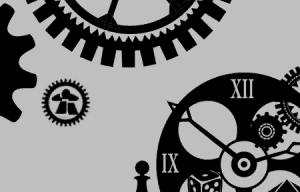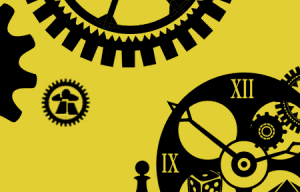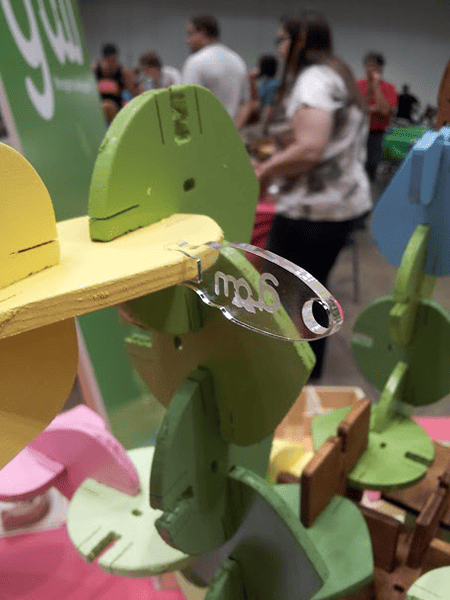
The following is a guest post from Tap Pribbenow and Nina Park from CriKeT Games. They currently have a game on Kickstarter, a tactile building game called Grow.
It’s an interesting dilemma for indie creators whether or not to launch during, after, before, or nowhere near a con, and this topic is often brought up on best practices boards. While the campaign for Grow is not done reaching for its goal, Tap and Nina have a post-mortem to share on the August con season.
—
Going to conventions is a great way to get the word out there about your game. Recently the team here at CriKeT Games went out to Gen Con and PAX Prime in order to promote Grow: The organic building game on Kickstarter. Grow is a 2013 Tabletop Deathmatch finalist, a 2014 IndieCade@E3 selection, and a 2014 PAX Prime Indie MEGABOOTH selection.
…AND ALL THAT MEANS ABSOLUTELY NOTHING IF WE CANNOT TRANSLATE THE ATTENTION INTO BACKERS.

We scheduled our campaign to extend over 2 cons, Gen Con Indy and PAX Prime, in order to fight the mid-campaign slump and promote our game in general. Each con helped us to raise approximately 10% of our campaign, and we only just reached 50% funding, statistically later than we should have. For most of the team, Gen Con was the first major tabletop convention we had been to, let alone showcased at, so it was very much a learning experience.
Hopefully what we’ve learned about showcasing at a con will help out future devs who go out to promote their game.

As with anything, preparation is key. The earlier you know what to bring, the better. This requires some research about the space, which will never provide perfectly accurate information. Things like table size, height, size of walkways, major traffic centers and the size of sign allowed are things you want to know if at all possible. With Grow, we brought:
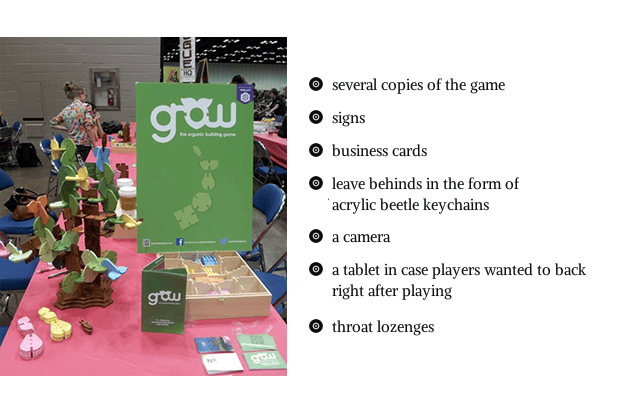
SIGNS AND BUSINESS CARDS
Signs and business cards of course, are a must in order to let potential players know what your game is and where they can find out more about your game. Key information that should be on there is:
- game name/logo
- your website
- social media outlets
- where your Kickstarter campaign can be found
At both Gen Con and PAX we would often find our team busy running games and wouldn’t be able to fully explain the game to anybody who stopped by. However, we directed people to take a business card and when we ran out of cards, we asked potential backers to take a picture of our sign.
BEETLES
Leave behinds are a great idea and for us the acrylic beetles worked well to promote Grow.

We learned that at cons badge swag and personalization are very important to attendees, so we told them they could clip the beetle to their badge. Our hope was that the beetles would be prominently displayed on the badge and make people ask after Grow and where they got the beetle. We could only use the beetles at Gen Con however since their design made it so that they only worked with lobster clasp badges. Buttons or pins are usually a safe bet as leave behinds since most cons provide cloth lanyards that they can be clipped to.
CAMERA
Bringing a camera is also a great idea and allowed us to take some promotional photos of Grow, giving us content to post to our social media outlets. The one thing with that however is that you may need to print out waivers for players to sign. It’s possible to get around this though by not taking a photo with a player’s face in it.
EXTRAS
Extra construction materials (like tape, glue, scissors, box cutters, etc.) are also a good idea to have around in case your sign or game needs any on the spot fixes. While we ourselves didn’t realize to bring such materials, our booth neighbors Titans Tactics were well prepared and kind enough to lend us anything we needed.
LOZENGES AND WATER
Lastly, and possibly most importantly, bring throat lozenges and water. These were vital to us especially since we were demoing a board game which required our team to explain Grow to new players. Lozenges soothe your throat which becomes raw after talking for so long and are necessary if you want to keep your voice throughout the convention.
—

The team here at CriKeT Games learned that, more often than not, you won’t be able to choose the location of your booth. At Gen Con, the table we had was out of the way and far from the main walkways in the exhibition hall. During less trafficked hours, like lunch, not many people would walk our way. At PAX, our booth was not optimal for board games. We had to compete for attention from loud, distracting video games in addition to our area being poorly lit, casting awkward lighting and shadows on the game.
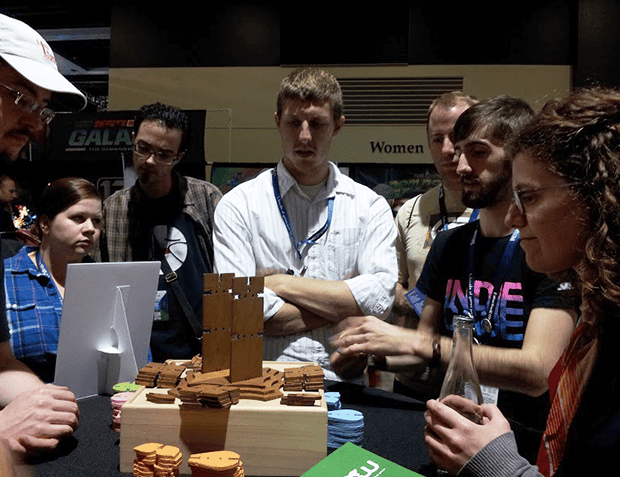
There are, however, ways around a poor location. At both cons, we created the opportunity to showcase elsewhere in the convention center. At Gen Con, we would sometimes assemble a display or play a game on an empty table closer to the main walkway. We even did so outside the hall at the end of the day and received some attention in this way. At PAX the Titans Tactics team discovered a local game shop had demo spaces on a different floor. The space was quieter and dedicated to board games specifically, demoing Grow there was quieter and more manageable, offering better retention despite the lower traffic.
We were also able to secure a demo after con hours at a local gaming cafe called Uptown Espresso and Gameporium while in Seattle. This was a great opportunity to reach out to a local crowd of players that didn’t necessarily want to engage in the craziness of PAX. We actually met the owner at GenCon and were able to set up the demo night for PAX. Keep an eye out for opening similar doors for yourself to maximize your visibility when at a con. Your trip will likely be prohibitively expensive (especially for an indie) and so you want to get the most out of it.
—

Before going to a con, it’s a great idea to have your elevator pitch down and know the key strengths of your game.
For Grow, the team understood that it was very visually striking, so we always set up a display with the game, sign, rulebook, and business cards prominently showcased at the end of our table.
While people were walking by, many people slowed or stopped because of the visuals alone, presenting us the opportunity to walk up to them and say hello. One thing that many people don’t realize about pitching a game is that you actually have to ask people to do things. Ask them if they want to hear about it, then ask them if they’d like to play. Afterwards ask them to back the project. We only had 3 copies of Grow at Gen Con and only enough space for 1 at PAX. One game could anywhere from thirty minutes to an hour. It was in our best interest to offer a game to people who seemed highly interested instead of someone who would accept only out of politeness. Have not only your full explanation but a quick pitch also planned out. The quick pitch can be given to attendees who you can tell immediately are only listening out of politeness.
—

This was the hardest part of the con experience and a problem that we struggled with throughout. While we did have a tablet on hand, most players were either uncomfortable with typing out their credit card information on a device that was not theirs or needed time to think about whether they would back. We shifted later on in both conventions to trying to get people on our mailing list, as was suggested to us by many other devs, but even with that our response was dismal.
The players who were very enthusiastic and wanted to back then and there usually did so on their own phone or tablet, and when asked to email just took our card, rendering our tablet unnecessary for the most part. This has proved to be a huge problem for us, as the final step in pushing people to back was out of our hands. We had to trust that peoples’ enthusiasm stayed with them until they got home and pushed that button, but the numbers show that many did not for whatever reason.
—

We’re still working on how to solve these problem ourselves, but we’ve had a couple of ideas and been given several suggestions on how to solve them. There’s not much you can do about location, but preparation and mitigate a lot of issues you may come across. Whether you have your own table/booth or are in a showcase such as the Indie MEGABOOTH, there are probably other devs you can contact and ask what they might be bringing.
Don’t be afraid to get information from your peers, we’re usually nice people. 🙂 You can also talk to the events manager of whatever event you’re attending and get specific information on table sizes, height, and convention layout, which might give you a better idea of what you’re dealing with.
Regarding emails, Paul Tseng, creator of Outer Earth, suggested we simply digitally sign people up for a mailing list. Having potential backers digitally sign up rather than simply writing their name on a piece of paper ensures you won’t have trouble reading someone’s handwriting. The best way to facilitate this is probably to display a tablet front and center on you booth/table with a sign announcing “sign-up for our emailing list!” Once again, remembering to actually ask people to help you is surprisingly effective.
Another idea given to us was to hold a raffle at the con. If someone could prove that they signed up during the con, they would be entered to win something such as an iPad. Giving away a copy of the game wouldn’t work in this case as the attendee already signed up for your Kickstarter (and presumably ordered a copy) but the contest encourages a fast turnaround on backers, generating a lot of momentum and paying for your prize fairly quickly.
—

In the end we had a great experience at both GenCon and PAX Prime, meeting a lot of wonderful people and generating a lot of interest for Grow. We’re still working towards our funding goal but we’re quite positive. Cons are often a double-edged sword when it comes to marketing your indie game, and we’re usually at the mercy of small things like layout, lighting, and running out of duct tape. Hopefully learning from what we’ve done can help you in the future.
DON’T BE AFRAID TO GO TO CONS WITH YOUR GAME AND FAIL A BIT YOURSELF, AS THAT IS BY FAR THE BEST TEACHER.
—
TAP PRIBBENOW:
Tap is the Lead Designer for Grow: The Organic Building Game and one of the founders of CriKeT Games. Like the other founders, he has a background in digital games, as a designer programmer, and focusses mostly on his own independent development projects. However through the development of Grow he has found a burning passion for tabletop gaming, and plans to pursue a future in both.
NINA PARK:
Nina is the Media Coordinator for Grow: The Organic Building Game. She has a passion for independent development teams both in digital and tabletop games, and strives to fill in the gaps most of those teams possess in marketing and production skills.
Grow: The Organic Building Game on Kickstarter!

